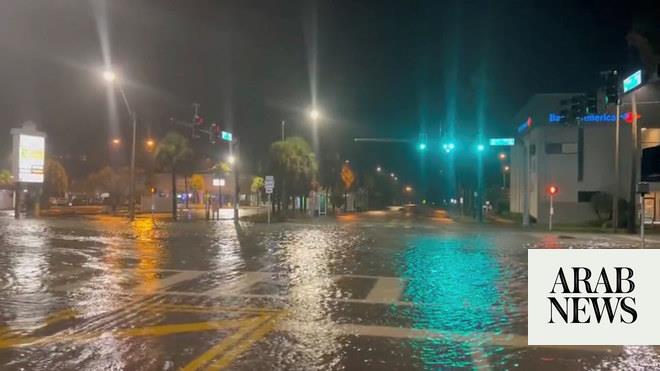
Thousands of residents evacuated homes on Sunday as subtropical Storm Alberto is expected to slam into the Florida Panhandle about mid-afternoon Monday.
Heading north through the Gulf of Mexico, the storm is expected to wallop parts of the southeastern United States with drenching rains, blasting winds and possible tornadoes, officials said.
“It’s maintained its strength and wind speeds overnight, and it looks like it’s headed for landfall at Panama City, (Florida),” said David Roth, a meteorologist with the National Weather Service’s Weather Prediction Center in College Park, Maryland.
“It’ll probably hit land either mid or late afternoon,” he said. “It has maximum sustained winds of 65 mph, which is about 10 miles shy of being a hurricane. This is definitely a dangerous storm.”
Forecasters said it could bring life-threatening inundation to Southern coastal states.
Lifeguards posted red flags along the white sands of Pensacola Beach, where swimming and wading were banned amid high surf and dangerous conditions.
The National Hurricane Center said a tropical storm warning was in effect from the Suwannee River in Florida to the Mississippi-Alabama state line.
Alberto, the first named Atlantic storm of 2018, which spun up days before the formal June 1 start of the hurricane season.
Alberto was expected to drop as much as 12 inches (30 cm) of rain, slamming an area from Mississippi to western Georgia, the Miami-based hurricane center said.
After that, it will bring powerful winds and heavy rains as it moves into the Tennessee Valley on Tuesday and Wednesday, the hurricane center said. The storm comes during the Memorial Day weekend and was expected to scramble transportation on Monday as many people return from holiday travel.
Alberto was also forecast to bring storm swells of about 2 to 4 feet (60-120 cm) to low-lying areas that were “likely to cause life-threatening surf and rip current conditions”.
A water spout, a dangerous vortex of wind and water, was spotted late Sunday about 7 miles off shore of Alligator Point, Florida, said Roth.
Franklin County, in the Florida Panhandle, has issued a mandatory evacuation for its barrier islands in the Gulf of Mexico affecting some 4,200 housing units, while Taylor County, to the east, has a voluntary evacuation order in place for its coastal areas.
Florida Governor Rick Scott, who issued a state of emergency on Saturday in all of the state’s 67 counties, said on Sunday that the Florida National Guard had 5,500 guard members ready to be deployed if needed.
“If evacuations have been ordered in your community, do not ignore them,” Scott said on Twitter.
Governors in Alabama and Mississippi also declared states of emergency on Saturday.
There were a number of deadly hurricanes in the United States and Caribbean last year that pummeled places including Texas, Florida and Puerto Rico, causing hundreds of billions of dollars in damage, massive power outages and devastation to hundreds of thousands of structures.
Alberto’s projected storm track has shifted eastward since Friday, lessening its threat to the active oil production areas in the Gulf of Mexico. Royal Dutch Shell Plc, Exxon Mobil Corp and Chevron Corp have evacuated some personnel from offshore Gulf oil facilities.
A subtropical storm like Alberto has a less defined and cooler center than a tropical storm, and its strongest winds are found farther from its center. Subtropical storms can develop into tropical storms, which in turn can strengthen into hurricanes.
A separate storm system on Sunday caused flash flooding in the Baltimore suburb of Ellicott City, Maryland, turning its historic Main Street into a raging river with water reaching past the first floor of buildings and sweeping cars down the road, local news video showed.
Governor Larry Hogan declared a state of emergency for the area rebuilding from a devastating flood about two years ago that killed two people and damaged dozens of buildings.
The National Oceanic and Atmospheric Administration released a hurricane season forecast Thursday that calls for 10 to 16 named storms, with five to nine hurricanes. One to four hurricanes could be "major" with sustained winds of at least 111 mph (178 kph).
If that forecast holds, it would make for a near-normal or above-normal season. An average hurricane season produces 12 named storms, of which six become hurricanes, including three major hurricanes.
"There are no strong climate signals saying its going to be extremely active, like last year, or extremely weak," said Gerry Bell, the lead hurricane forecaster at NOAAs Climate Prediction Center.












